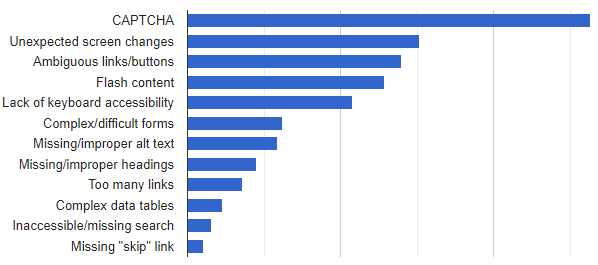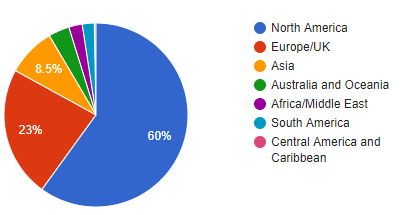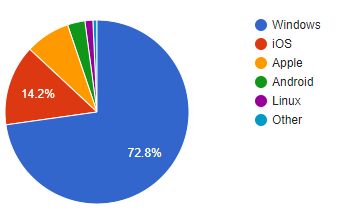0LAUK0 PRE2018 3 Group 13 User Research: Difference between revisions
| Line 10: | Line 10: | ||
3.1 Over 95% of the responses indicate that they suffer from blindness or visual-impairment. As of such, their opinions are relevant to us. | 3.1 Over 95% of the responses indicate that they suffer from blindness or visual-impairment. As of such, their opinions are relevant to us. | ||
[[File:Srv_demographic.PNG]] | [[File:Srv_demographic.PNG]] | ||
3.2 A strong majority shows that they primarily use the Windows operating system and a lot use the Apple's OS. Only a very small percentage use lesser common systems like Linux or others. | 3.2 A strong majority shows that they primarily use the Windows operating system and a lot use the Apple's OS. Only a very small percentage use lesser common systems like Linux or others. | ||
[[File:Srv_os.PNG]] | [[File:Srv_os.PNG]] | ||
3.3 The survey asked respondents to select their most, second most and third most problematic items from a list. In giving each selected item a weighting, the following chart shows the overall rating of difficulty and frustration for each item. | 3.3 The survey asked respondents to select their most, second most and third most problematic items from a list. In giving each selected item a weighting, the following chart shows the overall rating of difficulty and frustration for each item. | ||
[[File:Srv_problem.PNG]] | [[File:Srv_problem.PNG]] | ||
Most of these items are either simply constraints to blind people or cause unexpected visual changes. Either way they relies on visual perception and create an understanding problem to blind users. | Most of these items are either simply constraints to blind people or cause unexpected visual changes. Either way they relies on visual perception and create an understanding problem to blind users. | ||
Revision as of 00:02, 27 March 2019
Introduction
This page contains the user research performed by group 13 for the course Project Robots Everywhere (0LAUK0). Here we summarize the results of our own surveys as well as those that are available online. Using this information, we determine the desired functionality and set corresponding user requirements.
Summary
Survey results
The following survey results are taken out of the reference source and only contains information relevant to our case. As of such, in order to view the entire full survey, we recommend you to look at the reference link.
3. Screen Reader User Survey looked into the preferences of screen reader users. They have received 1792 valid responses and it was a follow-up to six previous surveys conducted between January 2009 and July 2015.
3.1 Over 95% of the responses indicate that they suffer from blindness or visual-impairment. As of such, their opinions are relevant to us.
3.2 A strong majority shows that they primarily use the Windows operating system and a lot use the Apple's OS. Only a very small percentage use lesser common systems like Linux or others.
3.3 The survey asked respondents to select their most, second most and third most problematic items from a list. In giving each selected item a weighting, the following chart shows the overall rating of difficulty and frustration for each item.

References
Group 13 survey results
1. https://drive.google.com/file/d/1a6CgYqBcHCB3pD2HzhYHlJ-2P9snBcFE/view?usp=sharing 2. https://drive.google.com/file/d/1-KIIQkl0nYmRsft4FWjfrHaNySzV_B5I/view?usp=sharing
Online survey results
3. Screen Reader User Survey #7 Results. WebAIM, October 2017. Available at: https://webaim.org/projects/screenreadersurvey7/ 4.

